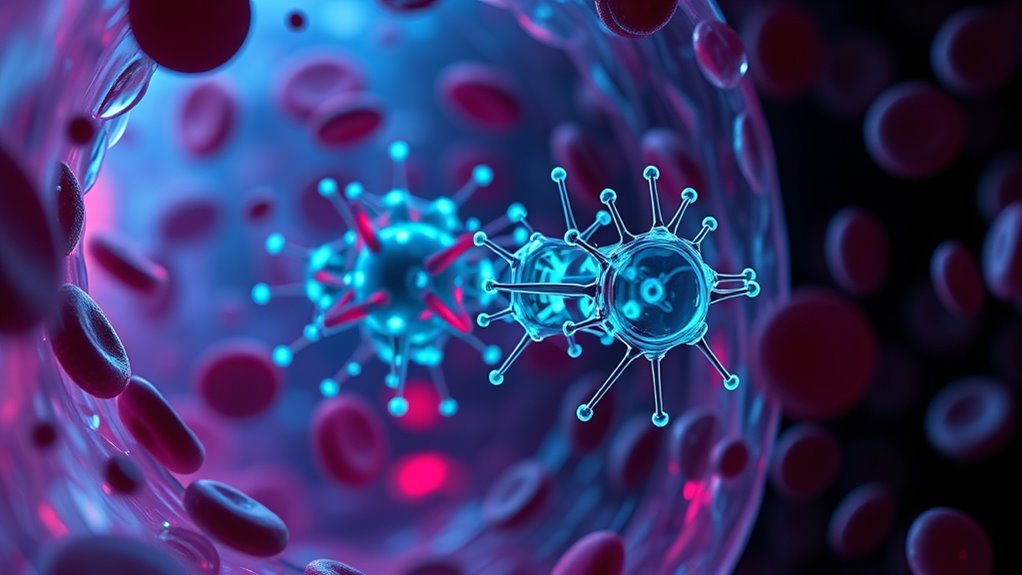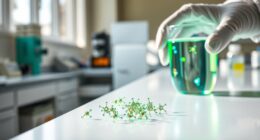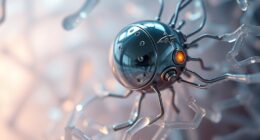Nanotheranostics combines nanotechnology with diagnostics and therapy to help you detect and treat diseases more precisely. It uses tiny materials like gold nanoparticles, liposomes, or carbon-based nanomaterials to target specific cells or tissues, often responding to environmental cues for controlled drug release. With advanced imaging capabilities, it allows real-time monitoring of treatment progress. If you’re curious about how this innovative approach is transforming healthcare, there’s more to discover ahead.
Key Takeaways
- Nanotheranostics integrates nanotechnology with diagnostic imaging and targeted therapy for personalized disease management.
- It employs multifunctional nanomaterials to detect and treat diseases simultaneously, improving accuracy and efficacy.
- These platforms enable real-time monitoring of treatment response through embedded imaging agents.
- Targeted delivery minimizes side effects by directing therapeutics specifically to diseased cells or tissues.
- Challenges include ensuring safety, scalability, and regulatory approval for complex multifunctional nanomedicines.
The Fundamental Principles of Nanotheranostics

Nanotheranostics combines nanotechnology with diagnostic and therapeutic functions to improve disease detection and treatment. At its core, it relies on nanoscale materials that can target specific cells or tissues, delivering drugs precisely where needed. These tiny platforms are engineered to respond to environmental cues, such as pH or temperature changes, enabling controlled release of therapies. Simultaneously, they incorporate imaging agents, allowing real-time tracking and diagnosis. The fundamental principle is integration: combining diagnosis and therapy into one system enhances efficiency and personalization of treatment. This approach minimizes side effects and maximizes efficacy by focusing on diseased areas. By understanding these core concepts, you can appreciate how nanotheranostics paves the way for smarter, more precise medical interventions.
Types of Nanomaterials Used in Combined Platforms

Various nanomaterials serve as the building blocks of nanotheranostic platforms, each offering unique properties that enhance diagnosis and therapy. You’ll find metallic nanoparticles like gold and silver, which provide excellent imaging contrast and photothermal effects. Lipid-based nanomaterials, such as liposomes, enable targeted drug delivery with biocompatibility. Polymer nanoparticles, including PLGA, allow controlled release and stability. Carbon-based materials like graphene oxide offer high surface area for functionalization and multimodal imaging. Additionally, research indicates that sound healing science is being explored to develop innovative synergistic approaches in nanomedicine. Here’s a quick comparison:
| Nanomaterial | Key Features |
|---|---|
| Gold nanoparticles | Bright imaging, photothermal therapy |
| Liposomes | Biocompatible, targeted drug delivery |
| Polymer nanoparticles | Controlled release, stability |
| Graphene oxide | High surface area, multimodal imaging capabilities |
These materials form the foundation of versatile nanotheranostic systems.
Advances in Disease Detection and Monitoring
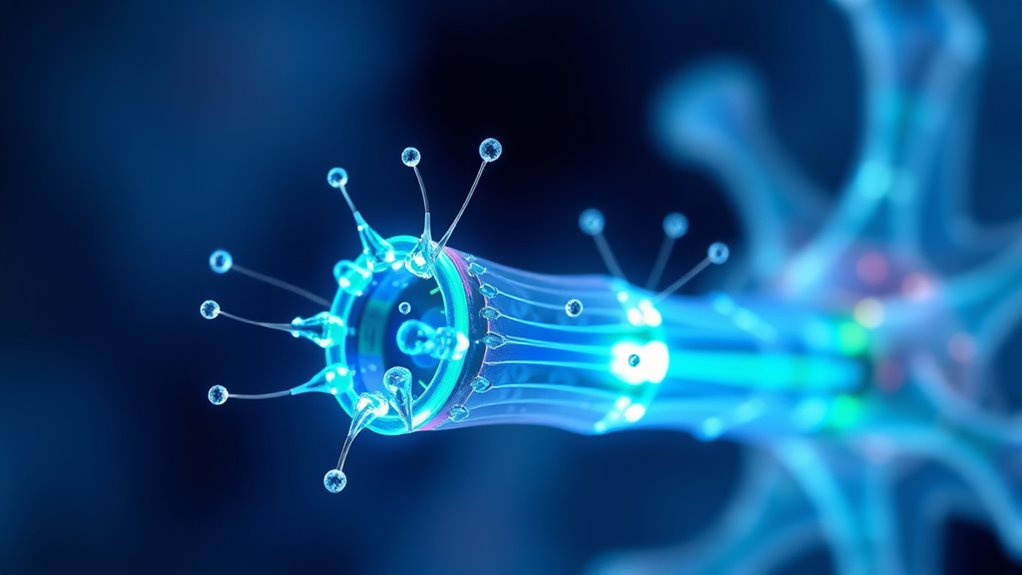
Recent advances in nanotheranostics have considerably improved disease detection and monitoring by enabling highly sensitive and specific diagnostic tools. You can now detect diseases at much earlier stages, thanks to nanomaterials that enhance imaging techniques like MRI, PET, and fluorescence. These nanoprobes target biomarkers directly, providing real-time insights into disease progression. You benefit from increased accuracy, reducing false positives and negatives. Additionally, nanotheranostics allow for multiplexed detection, identifying multiple disease markers simultaneously. This rapid, precise monitoring helps tailor treatment plans and track therapy effectiveness over time. The integration of nanotechnology into diagnostic platforms revolutionizes how you identify and follow diseases, making early intervention and personalized medicine more feasible and effective than ever before. The ability to detect biomarkers early is a key factor driving these innovations, enabling earlier diagnosis and improved patient outcomes.
Targeted Treatment Strategies Enabled by Nanotechnology
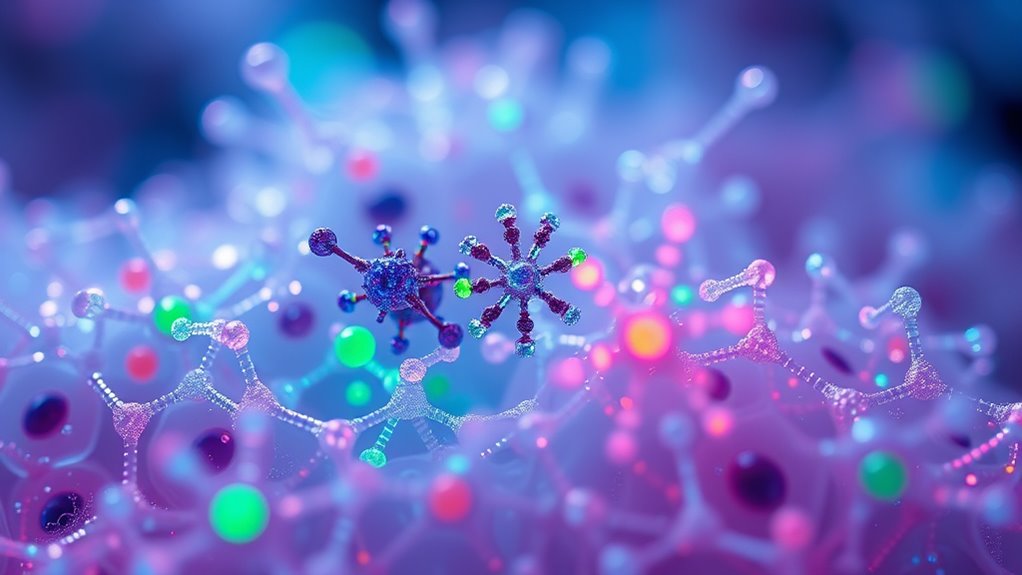
By directly delivering therapeutic agents to diseased cells, nanotechnology enhances treatment precision and minimizes side effects. You can use nanocarriers, such as liposomes and polymeric nanoparticles, to target specific tissues or cell types, reducing off-target toxicity. These carriers can be customized with surface molecules that recognize disease markers, ensuring drugs reach the intended site. This approach improves drug efficacy by increasing concentration at the disease site while lowering systemic exposure. Additionally, nanotechnology enables controlled release, maintaining ideal therapeutic levels over time. Combining targeting and controlled release strategies allows you to minimize drug doses, reduce adverse reactions, and improve patient outcomes. Furthermore, understanding the contrast ratio is crucial for optimizing imaging during treatment assessment. Overall, nanotechnology-driven targeted treatments offer a more effective, safer alternative to traditional therapies.
Future Perspectives and Challenges in the Field

As nanotechnology-driven targeted treatments become more refined, addressing the future landscape of nanotheranostics involves overcoming significant hurdles. You’ll need to tackle issues like ensuring safety, improving biocompatibility, and achieving precise targeting without off-site effects. Regulatory pathways must adapt to accommodate complex multifunctional nanomaterials, which can slow clinical translation. Scalability remains a challenge; producing consistent, high-quality nanoparticles at large scale is tough. Additionally, ethical considerations around long-term effects and environmental impact demand attention. Research must focus on developing standardized protocols and robust testing methods. Mindfulness practices can also be integrated into research and clinical workflows to improve focus and reduce stress among practitioners. Collaboration across disciplines will be essential to navigate these challenges and realize nanotheranostics’ full potential in personalized medicine.
Frequently Asked Questions
How Do Nanotheranostics Compare Cost-Wise to Traditional Medical Methods?
Nanotheranostics tend to be more expensive upfront than traditional medical methods due to advanced technology and research costs. However, they can save you money in the long run by enabling earlier diagnosis and targeted treatment, reducing unnecessary procedures and hospital stays. While initial investments are higher, their potential for more effective and personalized care may offset costs over time, making them a worthwhile option in many cases.
Are There Any Known Long-Term Safety Risks Associated With Nanotheranostic Agents?
You should know that long-term safety risks of nanotheranostic agents are still being studied, so it’s a bit of a gray area. While they show promise, potential risks include toxicity, immune reactions, or unforeseen interactions in the body over time. Researchers are keeping a close eye on these issues, but it’s wise to stay cautious, as with any new technology, because time will tell if they’re as safe as we hope.
How Can Nanotheranostics Be Personalized for Individual Patient Needs?
You can personalize nanotheranostics by tailoring the nanoparticles to your specific genetic makeup, disease markers, and treatment response. This involves analyzing your biological data to design targeted agents that recognize your unique tumor or condition. By customizing the therapeutic payloads and diagnostic components, healthcare providers can optimize efficacy, minimize side effects, and improve overall treatment outcomes, making nanotheranostics a precise and patient-centric approach.
What Regulatory Hurdles Exist for Clinical Approval of Nanotheranostic Devices?
You face regulatory hurdles like ensuring safety, efficacy, and consistent manufacturing processes for nanotheranostic devices. Agencies such as the FDA require thorough testing, detailed documentation, and clear demonstration of benefits over existing options. You also need to address potential toxicity, long-term effects, and quality control issues. Stepping through these regulations can be complex and time-consuming, but meeting these standards is essential for clinical approval and patient safety.
How Scalable Are Current Nanotheranostic Manufacturing Processes?
You’ll find that current nanotheranostic manufacturing processes are moderately scalable, with production volumes reaching hundreds of grams to several kilograms. Imagine a factory producing enough nanomaterials to treat thousands of patients monthly. While advancements like automation and standardized protocols boost scalability, challenges remain in maintaining quality, consistency, and cost-efficiency as production scales up. So, although progress is promising, full industrial-scale manufacturing still needs further optimization.
Conclusion
Think of nanotheranostics as a skilled lighthouse keeper guiding ships safely through treacherous waters. By combining diagnostics and therapeutics, it illuminates hidden dangers and steers treatments precisely where needed. As the field advances, you’ll find yourself at the helm of a revolution, steering toward more effective, personalized care. Embrace this journey, knowing that each discovery brightens the path to better health, just like a lighthouse lighting the way through darkness.
